Verdict
While the Sony 65A80L might not be anything like the brightest OLED TV in town and costs more than most of its closest rivals, its eye for the finer things in picture quality life makes it a potential home cinema dream come true for serious home cinema fans who don’t mind dimming the lights on movie night.
Introduction
Sony’s philosophy of embracing every type of TV technology to offer something for everyone finds the regular OLED part of its range represented by the A80L.
By regular OLED I mean an OLED panel that takes the traditional WRGB approach rather than the Quantum Dot OLED system used in Sony’s A95L TV. The A80L doesn’t use the brightness-boosting Micro Lens Array technology sported by a few premium WOLED TVs, either – which makes sense, as it allows the A80L to be positioned as a more affordable option for serious home cinema fans.
With so much new competition vying for your attention, does the A80L still pack enough of a punch to stand out from the crowd?
Availability
The 65A80L is widely available – with one or two store exclusive design variations – in every major territory around the world. It costs £1,999 from major UK retailers at the time of writing, while in the US and Australia it’s going for $1,999.99 and A$3,795 respectively.
While the 65A80L is Sony’s affordable OLED option, these prices mean it costs substantially more than some key rivals right now. LG’s OLED65C3 and Philips’ 65OLED808 both cost just £1,599.
Design
- Super-slim extremities
- The screen is the speakers
- Two leg height settings
While the 65A80L isn’t the most glamorous TV, there’s an understated elegance to its slim frame and trim (at least at the edges) rear. Its build quality is outstanding too; a cut above most other mid-range OLED models.
The screen and its frame sit behind a front sheet that makes them appear to be on the same plane, further enhancing the minimalist feel, and it’s possible to attach the two provided ultra-slim metal feet tight under the screen’s corners, so they look like extensions of the screen surround rather than separate items.
I say it’s possible to attach the feet that way because handily there are other options. You can position them closer together if you need to put the TV on a narrow piece of furniture, and there are two different height settings so you can lift the screen a little if you want to tuck a soundbar underneath it.
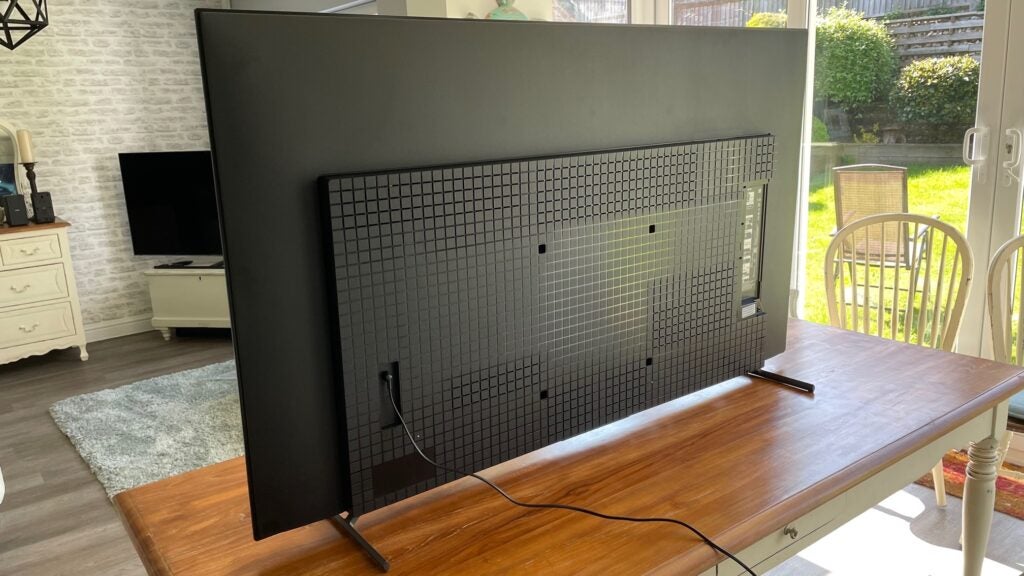
One reason the 65A80L can look so minimalistic is that it doesn’t have to accommodate regular speakers like most premium TVs do. Instead its Acoustic Surface Pro technology means the screen functions as its speakers.
While the 65A80L looks impressively slim from the front and slight angles, anyone thinking of wall hanging should be aware that a few inches in from the edges, the rear juts out substantially further than the rears of most OLED TVs.
Two remote control options are provided with the 65A80L. One ‘smart’ one with a built-in Google Assistant mic and buttons for a number of the most popular streaming services, and a smaller one with the usual number buttons but no mic or direct app buttons. Not surprisingly the smart remote got much more use during my testing.
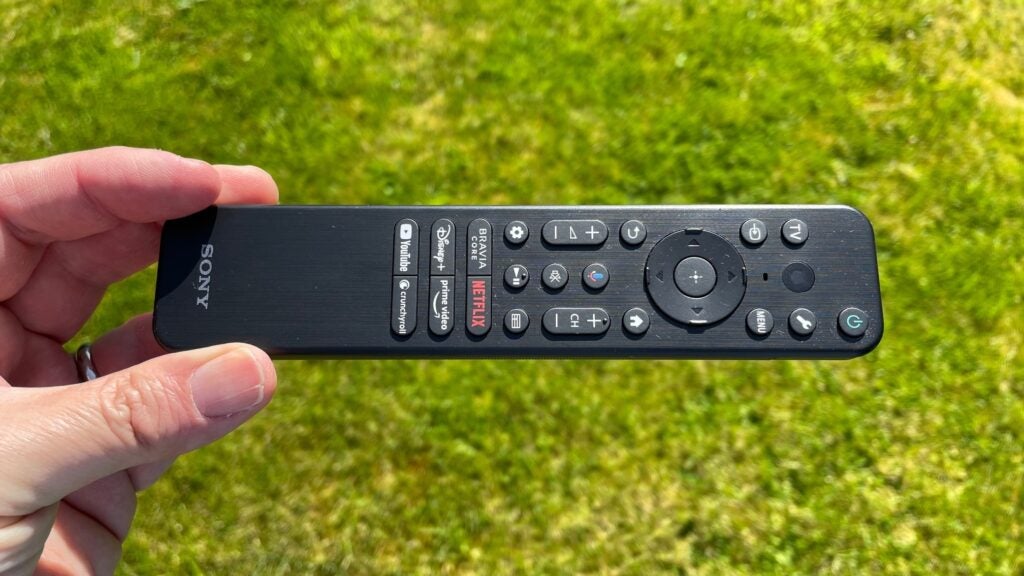
Features
- Cognitive XR processor
- 4K/120Hz and VRR gaming support
- Acoustic Surface Audio
The Sony XR-65A80L produces a peak light output of 800 nits on a 10% white HDR window – a figure which, while enough to show that the 65A80L is using a mid-range rather than basic panel, is still around 10% lower than the figures I’ve pulled from key mid-range rivals like the Philips 808 and LG C3 OLED models.
Hopefully providing compensation for this slightly low measurable brightness is Sony’s Cognitive XR processor. This has produced gorgeously refined, natural and lifelike pictures across a wide range of models for years now, and it’s bolstered for the A80L with a new XR Clear Image feature that focuses on better upscaling of high and standard definition to the screen’s native 4K resolution.
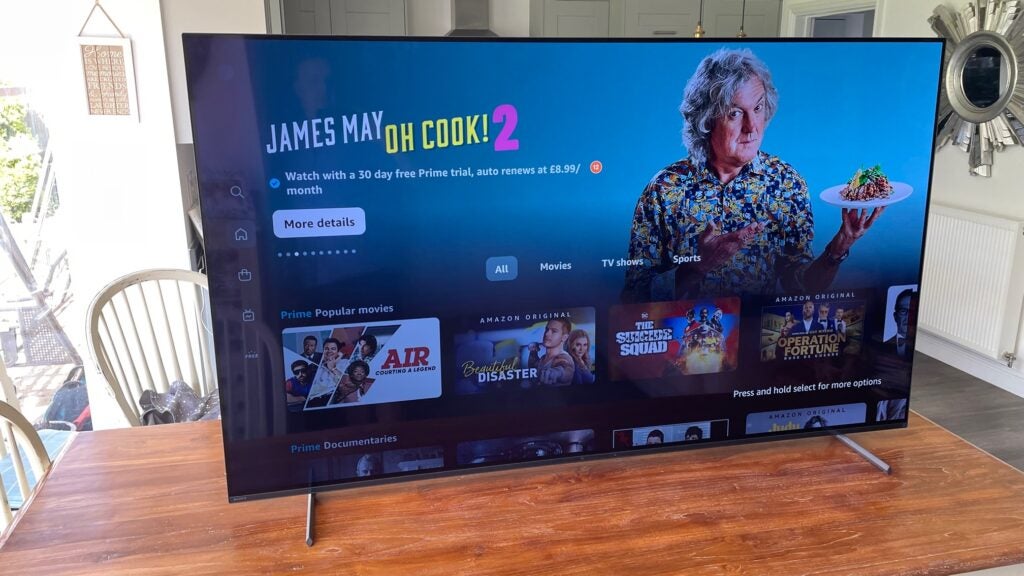
The Cognitive XR processor also carries the latest versions of the XR Triluminos Pro system for accurate colour mapping, XR OLED Motion for advanced motion processing, and an XR OLED Contrast Pro system which has proved capable before of optimising the contrast capabilities of OLED’s self-emissive approach to producing pictures. This has the potential to counter – at least perceptually – the 65A80L’s slightly low measured brightness.
As always with Sony’s mid-range and premium TVs, the A80L supports the Dolby Vision, HDR10 and HLG HDR formats, but ignores the HDR10+ format. This is a shame given that rivals such as Panasonic and Philips support all four main HDR systems, but HDR10+ content is at least relatively rare compared with the other formats.
The 65A80L has a couple of other relatively rare endorsements to its name, though: IMAX Enhanced and Netflix Calibrated certifications. The former means the TV has been designated as capable of unlocking the potential of the IMAX Enhanced mastering system with its emphasis on clarity and detail, while the latter means it can emulate the picture conditions Netflix uses when mastering the look of its home-grown shows.
Smart features on the 65A80L are delivered by the Google TV platform, and Sony has overcome Google’s blind spot with certain UK catch up apps by onboarding them separately. So the BBC iPlayer, ITVX, Channel 4 player and My5 streaming are all present and correct, alongside, Netflix, Prime Video, Disney+, Youtube, Apple TV and so on.
Connectivity is good rather than great for a mid-range TV. Which means that while there are four HDMI ports, only two have the bandwidth to support the latest gaming features of 4K/120Hz, variable refresh rates and auto low latency mode switching. Frustratingly, it’s not possible to enjoy both Dolby Vision and 120Hz refresh rates on the 65A80L simultaneously. You have to go into a special HDMI menu and choose between Dolby Vision and 120Hz depending on which feature matters most for the content you’re about to watch.
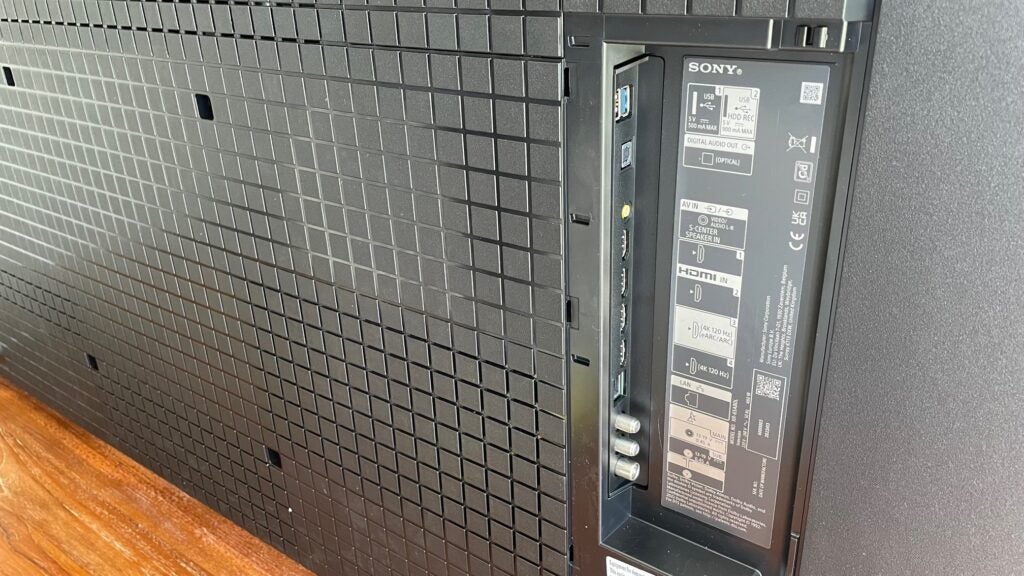
Other game-friendly features include a solid (though not world-beating) input lag in the 65A80L’s Game mode of just over 16ms, and a Game Menu that gives you rapid access to a series of gaming aids. These include a virtual crosshair, special gaming-based motion blur reduction, and a Black Equaliser option that elevates the brightness of dark picture areas to give you an edge at spotting hiding bad guys.
If you’re a PS5 owner, you can also take advantage of Sony’s Perfect for PlayStation 5 features. These include an Auto Genre Select option that’s pretty much the same as the ALLM feature, and a more useful Auto HDR Tone Mapping feature where the console can tell that it’s connected to the 65A80L and optimise its HDR output accordingly.
The 65A80L’s version of Sony’s unique Acoustic Surface technology finds actuators vibrating the screen to produce the TV’s sound. A sci-fi sounding approach that both saves the TV from having to fit lots of separate speakers into its bodywork, and ensures that rarest of audio things in the TV world: Sound that actually pushes directly towards you.
Picture Quality
- Beautifully refined and detailed images
- Excellent local contrast control
- Vivid mode is a bit nuts
In a TV world where we now have ultra-bright flagship OLED models out there such as the LG OLED65G3 and Samsung S95D, it’s clear right away that the 65A80L is far from the brightest kid on the OLED block. In fact, you can subjectively tell without any measuring gear that its pictures aren’t even as bright as most of its mid-range competition.
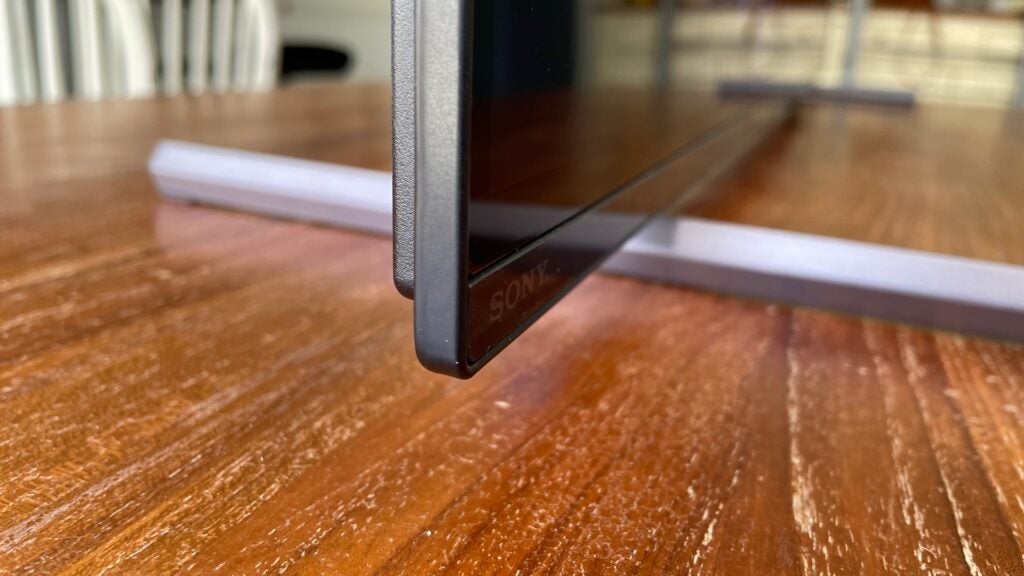
While this perhaps makes the 65A80L not the best option for a bright living room setting, it doesn’t by any means make it a poor TV. On the contrary, to the right sort of AV fan, the 65A80L’s pictures are pretty much a mid-range masterclass.
The key to its success lies in its love of the small things in picture quality life. For instance, in the darkest areas of the picture you can see outstanding amounts of detail and subtleties of shading that I’m not sure any other OLED out there at the moment can compete with. This is one area that even Samsung’s otherwise mighty S95D OLED sometimes struggles with.
The unusually adept handling of near-black picture information is achieved against a backdrop of exactly the gorgeously rich, deep, greyness-free black levels for which premium OLED is rightly beloved.
Colours might not enjoy the prodigious in-your-face volumes associated with the latest and brighter OLED models, but the subtlety with which they’re painted by the 65A80L’s Cognitive Processor XR really is exquisite. The resulting combination of light refinement in dark scenes and colour finesse brings out the 65A80L’s native 4K resolution without the set needing to resort to any obvious sharpness processing tricks, as well as introducing an almost uncanny sense of three-dimensionality to the picture.
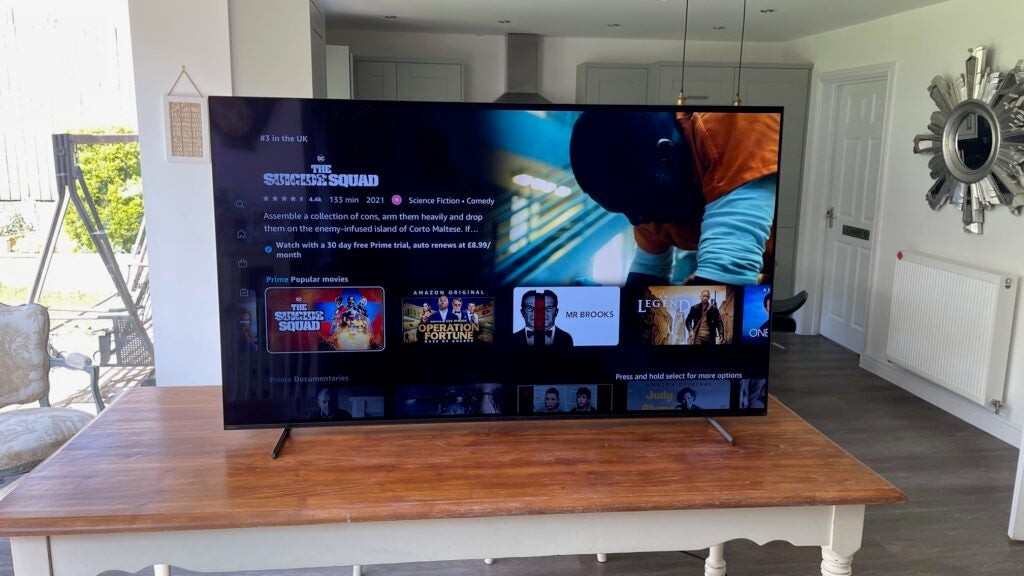
This sense of depth seems to owe a big debt to the screen’s ability to detect different objects and layers in the image and slightly tweak teach one individually to give it more or less prominence in the presentation. In effect, the 65A80L tries to interpret the picture in the same way your eyes interpret the real world, enhancing your sense of immersion in whatever TV show or movie you’re watching.
It does no harm to the immersive quality of the 65A80L’s pictures either that Sony’s class-leading motion processing is available to do a superb job of slightly de-emphasising judder with 24p sources without causing unwanted processing glitches or making the picture look too smooth for comfort. Especially in the motion processing’s True Cinema mode.
I realise there may be some home cinema purists wincing at this talk of subtle processing-based picture manipulation. If that’s you, rest assured the 65A80L does carry a couple of presets that leave pictures (almost) untouched if that’s what you want – and even in this clean state, they still look superb.
For me, though, Sony’s enhancements are applied with so much care and understanding that it’s hard not to love them.
The only outlandish exception to this is the 65A80L’s Vivid mode. While this does exactly what it says on the tin, letting the colours rip to the most extreme levels the OLED panel is capable of, it also jettisons far too much of that care and understanding so abundantly evident elsewhere. So more often than you’ll feel comfortable with, some of the boldest colours take on a painfully over-wrought and unrealistic appearance, sometimes succumbing to noise as they do so and losing the immaculate balance that’s otherwise the 65A80L’s picture trademark.
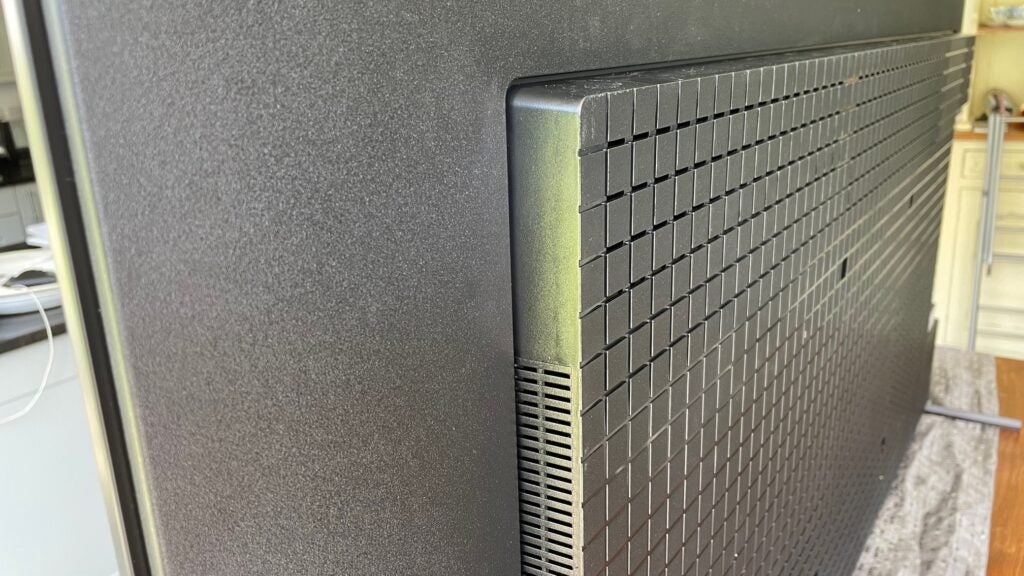
You can avoid the Vivid modes excesses simply by not selecting it. And in all the other numerous presets, despite offering plenty of variety for different tastes and sources, you’ll find pretty much nothing but mouthwatering picture goodness. So long as you accept that this is built on finesse, immersion and balance rather than anything in the least bit extreme.
Sound Quality
- Warm, open sound
- Impressively forward, direct presentation
- Excellent detail positioning
No other TVs make sound in the same way Sony’s OLEDs do – and as a result, few sound as good.
Using actuators to excite the screen into producing the TV’s sound is a masterstroke, enabling the 65A80L to create a sound stage that radiates forward towards you with much more directness and immersive intensity than most TV speaker systems do.
The screen as speaker approach also enables effects in complex (even Dolby Atmos) mixes to be placed on the screen with startling positional accuracy. You can even clearly hear noisy moving objects track across or around the screen in keeping with their on-screen placement.
There’s a lovely warm, open tone to the 65A80L’s sound too, that’s both generally easy on the ear and does a nifty job of disguising the fact that, despite the presence of subwoofers on the 65A80L’s rear, bass levels are actually a little limited.
Dialogue is clean and, again, accurately placed amid the action, and I was pleasantly surprised by how loud the TV could get given how its sound is produced. And in case you were wondering, even at maximum volume I saw no sign of the pictures in the sound-producing screen vibrating or shaking!
Latest deals
Should you buy it?
Buy it if you want really natural, accurate and subtle pictures
Arguably no other TV out there today can deliver the sort of light and colour subtleties the Sony 65A80L can.
Don’t buy it if you want a light canon.
If you have a very bright room to satisfy or just like a lot of brightness in your HDR pictures, the Sony 65A80L isn’t as bright as most of its OLED peers.
Final Thoughts
The Sony XR-65A80L isn’t the showiest, most obvious mid-range TV around today. There’s still a bounty of treasure to be had if you look a little deeper, as Sony’s processing and panel mastery eke out subtleties of colour, contrast, detail, balance and depth that more aggressive show-offs don’t always take the trouble to find.
The 65A80L sounds great, too, thanks to its innovative screen-as-speaker solution. The only real problem I have with it is its price. Costing £400 more than other mid-range OLED rivals feels a stretch – though at the same time, if you’re the sort of person who values the sort of subtlety that the 65A80L arguably uniquely promotes, what’s a few hundreds of pounds between friends?
How we test
We test every television we review thoroughly over an extended period of time. We use industry standard tests to compare features properly. We’ll always tell you what we find. We never, ever, accept money to review a product.
Find out more about how we test in our ethics policy.
FAQs
The 65A80L uses a mid-range WRGB OLED panel without the latest micro lens array technology.
An exclusive Sony system that uses actuators to turn an OLED TV’s screen into front firing speakers.
Two HDMIs support 4K/120Hz, variable refresh rates, auto HDR tone mapping with a PlayStation 5, auto genre mode switching
Jargon buster
OLED
OLED stands for Organic Light Emitting Diode. It’s a display made up of self emissive pixels, each of which can create its own light. A bright pixel can sit next to a dark pixel to help create deep black levels and high contrast beyond that of traditional displays. The lack of a backlight also means these displays can be thinner than other types of TVs.

























